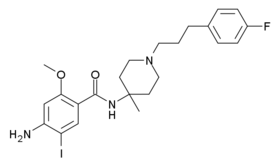5-I-R91150
5-I-R91150 (or R93274) is a compound that acts as a potent and selective antagonist of 5-HT2A receptors.[1] Its main application is as its iodine-123 radiolabeled form, in which it can be used in SPECT scanning[2] in human neuroimaging studies, to examine the distribution of the 5-HT2A receptor subtype in the brain, e.g. with respect to sex and age[3] and in adults with Asperger syndrome[4] or Alzheimer's disease.[5]
 | |
| Identifiers | |
|---|---|
IUPAC name
| |
| CAS Number | |
| PubChem CID | |
| ChemSpider | |
| CompTox Dashboard (EPA) | |
| Chemical and physical data | |
| Formula | C23H29FIN3O2 |
| Molar mass | 525.398 g·mol−1 |
| 3D model (JSmol) | |
SMILES
| |
InChI
| |
| | |
An alternative 5-HT2A receptor ligand also used in neuroimaging is altanserin.
References
- Peremans, K; Audenaert, K; Coopman, F; Jacobs, F; Dumont, F; Slegers, G; Verschooten, F; Van Bree, H; Mertens, J; Dierckx, R (2003). "Regional binding index of the radiolabeled selective 5-HT2A antagonist 123I-5-I-R91150 in the normal canine brain imaged with single photon emission computed tomography". Veterinary Radiology & Ultrasound. 44 (3): 344–51. PMID 12816380.
- Busatto, G. F.; Pilowsky, L. S.; Costa, D. C.; Mertens, J.; Terriere, D.; Ell, P. J.; Mulligan, R.; Travis, M. J.; Leysen, J. E. E.; Lui, D.; Gacinovic, S.; Waddington, W.; Lingford-Hughes, A.; Kerwin, R. W. (1997). "Initial evaluation of123|-5-|-R91150, a selective 5-HT2A ligand for single-photon emission tomography, in healthy human subjects". European Journal of Nuclear Medicine. 24 (2): 119–124. doi:10.1007/BF02439542. PMID 9021107.
- Baeken, Chris; d'Haenen, Hugo; Flamen, Patrick; Mertens, John; Terriere, Dirk; Chavatte, Kris; Boumon, Rony; Bossuyt, Axel (1998). "123 I-5-I-R91150, a new single-photon emission tomography ligand for 5-HT 2A receptors: Influence of age and gender in healthy subjects". European Journal of Nuclear Medicine and Molecular Imaging. 25 (12): 1617–1622. doi:10.1007/s002590050339.
- Murphy, D. G.M.; Daly, E.; Schmitz, N.; Toal, F.; Murphy, K.; Curran, S.; Erlandsson, K.; Eersels, J.; Kerwin, R.; Ell, P.; Travis, M. (2006). "Cortical Serotonin 5-HT2A Receptor Binding and Social Communication in Adults with Asperger's Syndrome: An in Vivo SPECT Study". American Journal of Psychiatry. 163 (5): 934–936. doi:10.1176/appi.ajp.163.5.934. PMID 16648340.
- Versijpt, J.; Van Laere, K.J.; Dumont, F.; Decoo, Danny; Vandecapelle, Marleen; Santens, Patrick; Goethals, Ingeborg; Audenaert, K.; Slegers, G.; Dierckx, Rudi A.; Korf, Jakob (2003). "Imaging of the 5-HT2A system: Age-, gender-, and Alzheimer's disease-related findings". Neurobiology of Aging. 24 (4): 553–561. doi:10.1016/S0197-4580(02)00137-9. PMID 12714112.
Further reading
- Catafau, A. M.; Danus, M.; Bullich, S.; Llop, J.; Perich, J.; Cunningham, V. J.; Plaza, P.; Penengo, M. M.; Eersels, J. L.; Squassante, L.; Ros, D.; Barbanoj, M. (2006). "Characterization of the SPECT 5-HT2A receptor ligand 123I-R91150 in healthy volunteers: Part 1--pseudoequilibrium interval and quantification methods". Journal of Nuclear Medicine. 47 (6): 919–928. PMID 16741300.
- Catafau, A. M.; Danus, M.; Bullich, S.; Nucci, G.; Llop, J.; Abanades, S.; Cunningham, V. J.; Eersels, J. L.; Pavia, J.; Farre, M. (2006). "Characterization of the SPECT 5-HT2A receptor ligand 123I-R91150 in healthy volunteers: Part 2--ketanserin displacement". Journal of Nuclear Medicine. 47 (6): 929–937. PMID 16741301.
This article is issued from
Wikipedia.
The text is licensed under Creative
Commons - Attribution - Sharealike.
Additional terms may apply for the media files.